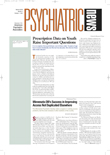Researchers found that the benefits of residential drug abuse treatment exceed costs by a factor of 4 to 1 in five programs in Washington state, when they used a benefit-cost analysis that considers societal costs.
Michael T. French, Ph.D., Helena J. Salome, and Molly Carney, Ph.D., used recently developed methods and guidelines for using the drug abuse treatment cost analysis (DATCAP) and the addiction severity index (ASI) to estimate the economic costs and benefits in five programs in Washington state that serve patients in publicly funded programs.
Their report, “Using the DATCAP and ASI to Estimate the Costs and Benefits of Residential Addiction Treatment in the State of Washington,” appears in the February issue of Social Science and Medicine.
Carney is a research scientist at the Alcohol and Drug Abuse Institute at the University of Washington, and French is a professor of health care economics at the Medical University of South Carolina. Salome is a Ph.D. candidate at the University of Miami.
“The average economic cost of treatment for this sample of residential clients in Washington state was $4,912. The average economic benefit was $21,329. The average net benefit of treatment was $16,418, and the benefit-cost ratio was 4.34,” they pointed out.
Data from the Office of Applied Studies suggest that approximately 70 percent of the total cost of addiction treatment in the United States is funded through public budgets.
According to the article, “the average cost of residential addiction treatment is about 5.69 times higher than the cost of outpatient nonmethadone services.”
So, according to the researchers, the value of residential addiction treatment is being reappraised by many state agencies.
Researchers estimated the economic cost by using the DATCAP, which was administered on site at each of the five residential programs. They determined treatment outcomes by analysis of client-specific baseline and follow-up data collected through the ASI.
The researchers derived estimates for average weekly and total cost of addiction treatment, total benefit of treatment, net benefit of treatment, and the benefit-cost ratio.
Benefit-cost analysis, they argued, is different from cost-effectiveness analysis and preferable to it when different outcomes of the treatment intervention must be included and programs with different goals or effects must be compared.
Benefit-cost analysis “compares the opportunity cost of an intervention to the total benefit, while expressing both in a common monetary metric. Benefit-cost measures include a benefit-cost ratio (i.e., benefit divided by cost) or simply a net benefit estimate (i.e., cost subtracted from benefit).”
Economic benefits were derived from patient self-reported information collected at the beginning of treatment and six months after discharge from the program.
The researchers converted the following ASI measures into dollar-equivalent values for the benefit analysis: inpatient medical days, inpatient psychiatric days, residential addiction treatment days (follow-up only), days experiencing medical problems, income received from employment, days engaged in illegal activities, and days experiencing psychological or emotional problems.
Reported number of days engaged in illegal activities was used to estimate the reduction in crime-related costs.
The researchers used multivariate regression models to determine which client and/or treatment characteristics were significantly related to economic cost and benefit.
Robert Rosenheck, M.D., director of the VA Northeast Program Evaluation Center and a professor of psychiatry and public health at Yale School of Medicine, told Psychiatric News, “This is a very important type of study, but one which, as the authors note, must be interpreted cautiously for two reasons. First, since there was no control group, we cannot be certain that the cost savings were the result of treatment. They may reflect the fact that improvement can come about as a result of some natural recovery process in people who have decided to get help. Second, although measuring the economic value of health gains theoretically is very important, practically such measurement is very hard to accomplish.” ▪
